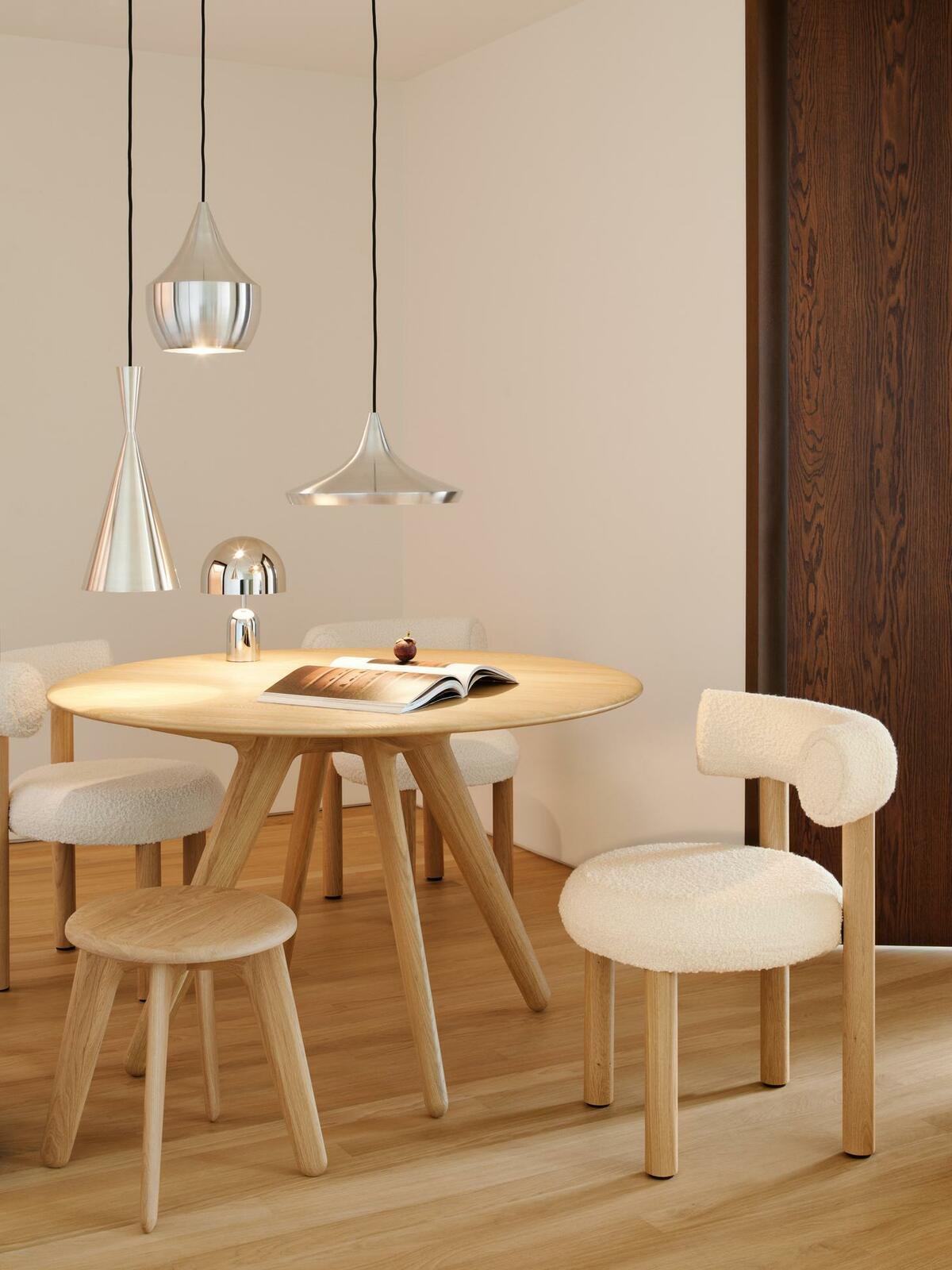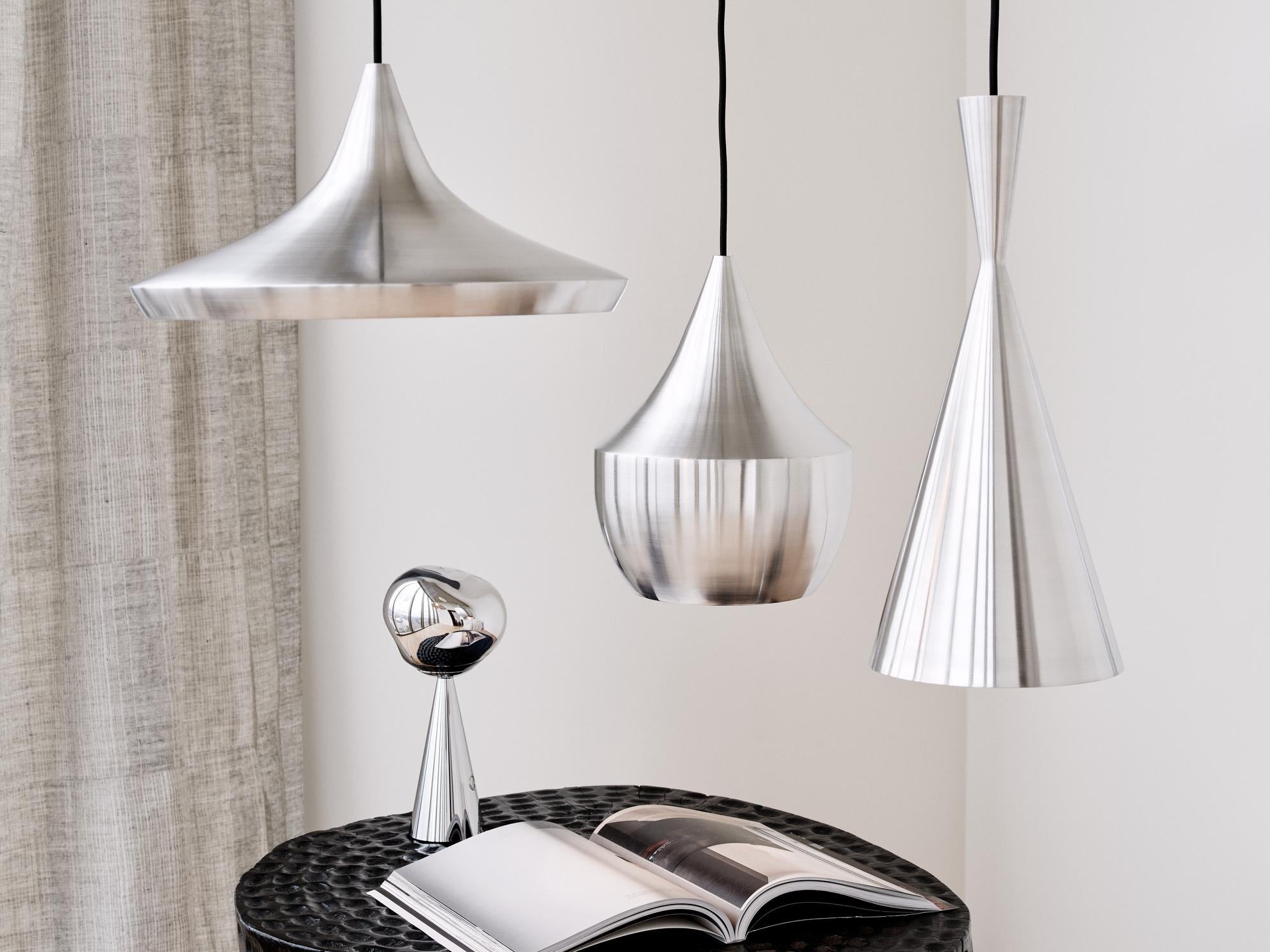When Tom Dixon launched his design label roughly two decades ago, the Beat light became one of its early successes: a half-dome lamp made from hand-hammered patinated brass by artisans in India. Today, the light is ubiquitous. Dixon has seen it everywhere—on visits to various factories, in shops across the world, even at a Starbucks in the Shanghai airport. The only problem? It’s not his.
Over the years, the market has been flooded with Beat knockoffs. There are crucial material differences from the original—the dupe is often made with thin aluminum instead of brass, for example, and the outside is usually covered in black spray paint to mimic the look of the original. Regardless, the fakes now far outnumber Dixon’s original design.

“We did an audit online recently to see how many were available,” says the designer. “It turned out to be 800,000 copies of our lamp—which is easily 20 times our actual production.” His company explored legal options to thwart the flood of phonies, but quickly found it had few paths for recourse.
Eventually, Dixon decided on a different approach: If you can’t beat ’em, join ’em.
“Rather than give in to the copiers or get angry about it, I decided that just like a karate master, I would use my opponent’s strength against him,” he says.
At this year’s 3 Days of Design festival in Copenhagen, Dixon will debut Unbeaten: More affordable than the original Beat, but more upscale than the knockoffs, it’s made with a thicker-grade, raw recycled aluminum instead of fake brass, and it’s outfitted with copper LED lights instead of a bulbless socket. While he initially explored producing the pieces at one of the manufacturing centers in China where many fakes proliferate, the designer ended up opting to utilize the same factories in India where the Beat lights are made in order to avoid sacrificing quality. The end result is not quite as cheap as the knockoffs you can find online (which go for as little as $55), but at $325, it’s about half the price of the original, which costs anywhere from $552 to $3,834, depending on the model.
“The idea is to go in with two stories: One is about the amazing handicraft and noble materials, and the other is more about aluminum and machine technology and industrial products,” says Dixon. “We can go in telling the two stories of what makes value, because I think the modern world is really about transparency as well.”
Dixon is not alone in his knockoff predicament. According to industry advocacy organization Be Original Americas, U.S. Customs & Border Protection confiscated over $15 million in counterfeit furnishings in 2017—likely only a fraction of the knockoffs that make their way into the market. Taking legal action against the flow of fakes can be difficult. While copyright protection applies to pictorial or graphic elements, it does not extend to “useful or functional items” like lighting or furniture, according to Stacy Grossman, the advocacy organization’s intellectual property attorney. That doesn’t mean filing for copyright registration is entirely ineffective—it can be a useful tool for sending takedown notices to online marketplaces, she says—only that it can’t guarantee success against fakes.
Knowing this, should designers and brands start duping their own products in order to beat out the knockoffs?
“I see it as a win-win-win,” says Coleman Gutshall, president of Be Original Americas and vice president of strategic operations at Bernhardt Design. “It’s great for [designers or brands] and it’s great for the industry as a whole because you are putting out thoughtful design that’s actually addressing market needs—and it’s a better solution for the consumer than buying a faceless knockoff.”
In a broader sense, it’s territory many designers have treaded before: Michael Graves has designed for both Alessi and Target; GamFratesi has created works for Fritz Hansen, Ligne Roset, Bang & Olufsen, and Hay; Paola Navone has designed for Driade, FontanaArte and Gervasoni, plus the likes of Crate & Barrel.
When done right, the strategy of designing both high- and low-end pieces can work to broaden a brand’s reach. “This ‘disrupt yourself before you’re disrupted’ strategy is really a very positive one, if you can keep yourself elevated at the high end but then become more affordable at the lower end,” says Pamela Danziger, an expert in luxury market research.
As she points out, it’s a common approach in fashion: For Hermès, lower-priced items like scarves serve as an aspirational starting point on a path that leads to Kelly and Birkin bags; Chanel uses the same strategy with its cosmetics line.
There are potential pitfalls. If you’re offering a lower-budget version of one of your own high-end items, why should a consumer ever opt for the more expensive option? For Danziger, that’s exactly why it’s key to maintain separate distribution channels. She points to a brand like Coach, which strips down premium bags to their basics, then sells them at a reduced cost at an outlet store. In the home world, it might look something like Michael Graves designing his line for Target—a product assortment available exclusively through the retailer, not found on his site.
“It’s a stratification strategy, so it needs to be managed carefully with proper distribution,” says Danziger. “For a home company, it might be that you sell your exclusive brand in designer showrooms, and then you open up your lower end—maybe give it a different brand name—and sell it to more consumer-oriented furniture stores and showrooms.”
Dixon isn’t worried that introducing Unbeaten within the same line of distribution will siphon sales from the original Beat—in his view, the proliferation of knockoff pieces in the market already has. “In my mind, it’s nothing ventured, nothing gained,” he says. “You’ll see the objects in every single bar and sandwich shop, and I think that seeing them very widely distributed actually devalues them more than the price.”
As he points out, the makers of fakes have a leg up when it comes to mass production and distribution on a fast-to-market timeline. To make matters even trickier for designers, demand for dupes is higher than ever: The popularity of TikTok has spawned a cottage industry of shoppers looking expressly for lower-priced copycat products, leading the rise of sites like Dupe.com. If a designer finds a way to intercept that cultural phenomenon and extract some value for their brand, they might as well explore that avenue.
“However people figure out how to continue to push forward the world of design and creativity—whether that be by knocking themselves off or producing accessible products in conjunction with more rarefied products—all of that is in pursuit of newness and originality,” says Gutshall. “When you start talking about knockoffs, that all grinds to a halt because it’s no longer about trying to move the ball forward, it’s about copying the ball from the past.”



























